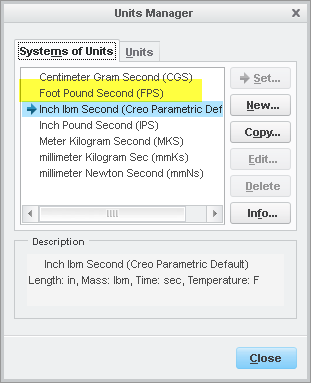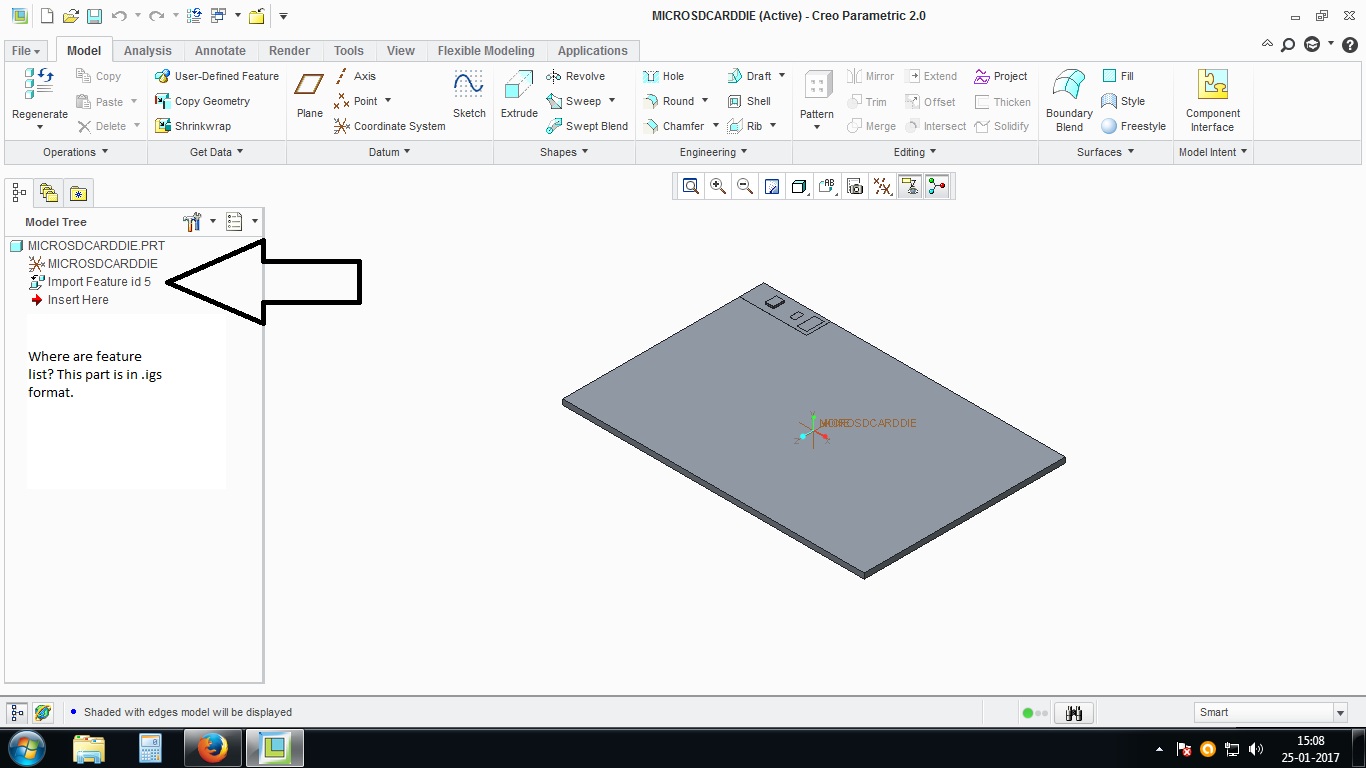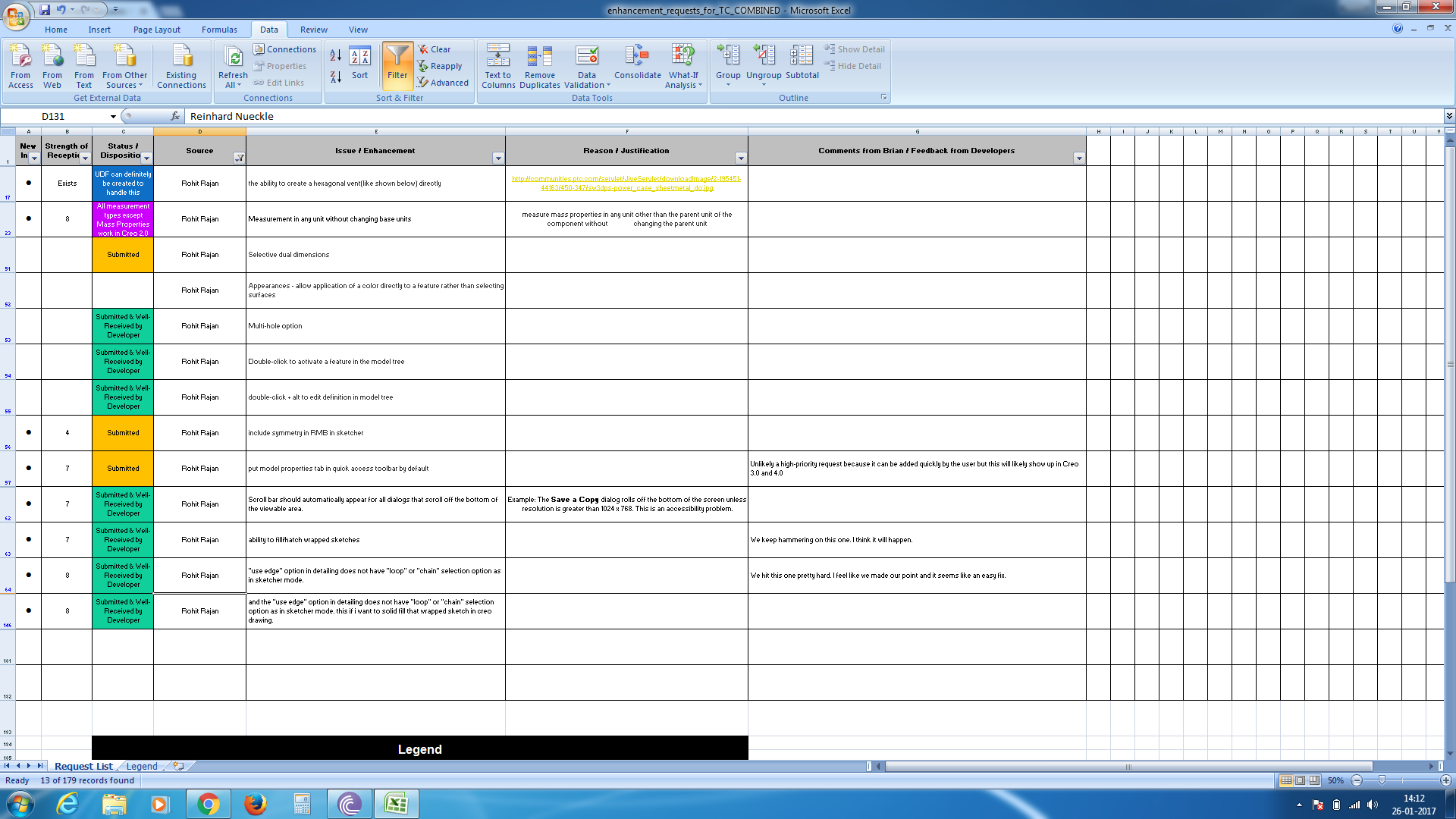Community Tip - Learn all about PTC Community Badges. Engage with PTC and see how many you can earn! X
- Community
- Creo+ and Creo Parametric
- 3D Part & Assembly Design
- Re: A list of diffculties that I have faced in cre...
- Subscribe to RSS Feed
- Mark Topic as New
- Mark Topic as Read
- Float this Topic for Current User
- Bookmark
- Subscribe
- Mute
- Printer Friendly Page
A list of diffculties that I have faced in creo,Interested to know what other creo users face while using creo?
- Mark as New
- Bookmark
- Subscribe
- Mute
- Subscribe to RSS Feed
- Permalink
- Notify Moderator
A list of diffculties that I have faced in creo,Interested to know what other creo users face while using creo?
Dear Creo Users,
This is the list of problems or queries I have faced while using PTC Creo. Is there any updates on these topics in creo 3.0 and 4.0?
Can anyone request PTC Developers to update PTC creo regarding this issue?
1) Pattern option ( at least Linear and Circular pattern) can be incorporated in Creo Sketch
2) Creo Sheetmetal Unbend option can be updated when unbending some complex blend, sweep or sweep blend options are used to make complicated hopper like parts in creo sheetmetal.
3) Creo sketch palette can be updated by incorporating some new mechanical related profiles.(Its true we can create our own sketch but it will be helpful if some complex mechanical profiles are incorporated in sketch palette)
4) Some tutorials in Learning Exchange and creo help can be updated regarding creo mechanism constraints like how to use ball, planar, general , bearing mechanism connection.
5) More materials can be incorporated in ptc creo materials so that it can be easy to filnd weight and density of many solid parts.
6) While converting iges or step file features are not present in creo. This conversion option can be updated so that if one can create a part in solid works or other cad softwares like NX, Catia or solid edge and convert into igs or stp file when open it in creo, all features like extrude, revolve he/she uses in solidworks or other cad softwares or all histories of part features are present and visible in creo so that anyone can modify it.
These are the problems that I have faced while using creo. I don't use the word that it should be updated but I use the word if it can be incorporated then it will be very helpful for other creo users. What do you think?
Any other enhancement that other creo users can think of in part modeling, surface modeling, drawing, sheetmetal ,assembly, mechanism are free to post in this discussion. I am hopeful Ptc developers may discuss the issues.
- Labels:
-
Data Exchange
- Tags:
- creo modelling
- Mark as New
- Bookmark
- Subscribe
- Mute
- Subscribe to RSS Feed
- Permalink
- Notify Moderator
Point no. 6
you mean when a step file is opened in Creo from other software it should have history tree?
I dont think even solidworks does that..Solidworks has a converter which tries to convert solids features in step or iges when opened in solidworrks..simple one it does..the difficult one it fails.
Even the ones which are converted are fully undefined.
Point no. 1
Already discussed when you put that question separately.
Point 5.
That has been a problem in pro/e -creo.Infact it is much better with Creo 4.0
You can join the PTC technical committee.Below is the link.
Other than Material table i dont think any other of your points is a "problem" as mentioned by you.![]()
- Mark as New
- Bookmark
- Subscribe
- Mute
- Subscribe to RSS Feed
- Permalink
- Notify Moderator
Hi Rohit,
Thanks for your answer
In Point number 6 I would definitely wish if all features have come in creo when I open step or igs file in creo.
While exploding an assembly I cannot place parts at a finite distance from another parts in Creo. Any updates or ideas on that on later versions??
Also in creo is there any unit system to draw parts in feet. because in inlbs_part _solid you can only draw in inches 10' and that ' sign is not accepted in creo. Any other suggestions or updates on that?
Another point I would like to introduce that Is there any way to hide weak dimensions in creo?
- Mark as New
- Bookmark
- Subscribe
- Mute
- Subscribe to RSS Feed
- Permalink
- Notify Moderator
Creo has flexible modelling...which can help in changing features which i think is much better than changing features.
As i mentioned before even solidworks has a converter but it fails to convert complex features.
Proe does have feature recognition but i dont think its that developed.
Creo 3.0 onwards we can directly open major cad software's parts and assembles directly in creo, again no history tree..and it remains linked with original cad model..
Yes you can draw in feet in Creo.(File>Model Properties>Units>Change)
Soumya the power of Creo lies in config.pro options.
- Mark as New
- Bookmark
- Subscribe
- Mute
- Subscribe to RSS Feed
- Permalink
- Notify Moderator
Hi,
I have tried to go file > model properties> units > change then which unit is for fit (')? inlbs_part_solid is for inches??
Any other ideas, suggestions or tutorial videos regarding point 4 in my list? Because in learning exchange and youtube there are no new and good tutorials on creo mechanism. What do you think?
With regards,
Soumya
- Mark as New
- Bookmark
- Subscribe
- Mute
- Subscribe to RSS Feed
- Permalink
- Notify Moderator
when you click on change ..there is option for "NEW" there you will find other units including feet.
- Mark as New
- Bookmark
- Subscribe
- Mute
- Subscribe to RSS Feed
- Permalink
- Notify Moderator
Soumya if you really need to learn creo you need to join some very good training.
Learning exchange has some good tutorials, try e-cognition tutorials. and you tube also.
There is specific way by which everything is done in Creo.
- Mark as New
- Bookmark
- Subscribe
- Mute
- Subscribe to RSS Feed
- Permalink
- Notify Moderator
Foot pound second (FPS). Foot, in imperial units, is often designated as ' (apostrophe)

- Mark as New
- Bookmark
- Subscribe
- Mute
- Subscribe to RSS Feed
- Permalink
- Notify Moderator
Soumya Bhattacharya wrote:
In Point number 6 I would definitely wish if all features have come in creo when I open step or igs file in creo.
STEP and IGES files simply do not contain this level of information - they only describe the final resulting surfaces.
Any attempt by the importing software to convert these back into features can only be a guess at the original design intent.
Let's say I import a cube with a hole through it. Was the complete shape extruded from one sketch (a square with a circle inside), or was a solid cube created and then the hole removed? Was the cube extruded parallel to the hole axis, or in one of the other directions? Was the hole extruded or revolved? Were the features created directly as solid features, or were they created as quilts first and then solidified? Do all of these methods even exist in the original CAD software (perhaps trivial in this case, but then start to consider a fill pattern along an equation curve, or a sweep using TRAJPAR, for example)?
- Mark as New
- Bookmark
- Subscribe
- Mute
- Subscribe to RSS Feed
- Permalink
- Notify Moderator
 Hi Jonathon,
Hi Jonathon,
You have misunderstood my point. I have attached a jpeg image. I hope you will understand my point if you watch the attached image. I am talking about feature list and history not how the feature is made of.
Thanks
With regards,
Soumya
- Mark as New
- Bookmark
- Subscribe
- Mute
- Subscribe to RSS Feed
- Permalink
- Notify Moderator
No, I think I have understood your point. IGES does not contain Creo features - it describes the part using its own set of primitives, which do not necessarily correspond directly to Creo features. Creo therefore imports these simply as a group of 'dumb' surfaces, which for simplicity are all grouped in a single 'import feature'. If you redefine the import feature and explore it (possibly using Import Data Doctor), you will find that it is just a large quilt made up of multiple individual surfaces.
If you want to keep a Creo feature tree in your model, then save it in Creo model format. This is not supported by STEP or IGES.
If the model originated in a different CAD system (say Solidworks, NX, or Catia) then the feature tree in that application may look very different to a Creo feature tree (for example, Catia allows the tree to be many levels deep including 'assembles' of multiple solid bodies), and so it would not be possible to convert it to Creo even if the information was contained in the STEP or IGES.
- Mark as New
- Bookmark
- Subscribe
- Mute
- Subscribe to RSS Feed
- Permalink
- Notify Moderator
Jonathan is exactly referring to what you are saying.
As i said before Solidworks does that with a converter but it fails with more complex features.
Creo does have feature recogniton but it is not that well developed.
That is why we have push pull options in some CAD softwares to make changes if the CAD file cannot be sent back for changes in the native format.
- Mark as New
- Bookmark
- Subscribe
- Mute
- Subscribe to RSS Feed
- Permalink
- Notify Moderator
Hi all,
Thanks for all of your answers. I hope in later versions in creo 3.0 and 4.0 we can open stp or igs files as a part file which includes all the features that we have used in other softwares.
I would like to add another point on my above list that is point no.7 which is it is very difficult to create helical curve in creo. We are creating helical sweep but helix curve is not present.
We can use intersect command to extract curve but if there is a option in curve called helical curve then it will be better for creo users. What other creo users think on this? Should I put this on separate discussion?
Another Point I would like to mention is that in creo hole feature we can create only one hole at a time. But in other cad softwares we can create multiple associated hole in one hole feature.There is no need to pattern everytime. Will it be better in creo later versions so that we can create multiple holes at a time in a single hole feature? I don' t know if there are any updates regarding this. What do you think?
Is there any new idea section in this forum?
- Mark as New
- Bookmark
- Subscribe
- Mute
- Subscribe to RSS Feed
- Permalink
- Notify Moderator
For the idea of opening iges or step files the feature in place, if it works as PTC claims you won't need to export iges or step files. One of the features they seem to be implementing starting with Creo 4 as I understand is you will be able to open other CAD software native files, which they have said was a goal since announcing Creo. We only saw a demo so I can't say for sure but they showed us an example where Solidworks and Catia part files were imported directly and they appeared to have the feature trees. If you left the parts alone they remain native files for the application they were created in once you modify and save they become Creo parts.
For the helical curve, the option for creating them is already present. You're probably interested more in a more user friendly interface for that defines the parameters needed to create one?
- Mark as New
- Bookmark
- Subscribe
- Mute
- Subscribe to RSS Feed
- Permalink
- Notify Moderator
It's good you are asking questions on this forum. It has a ton of good advice, and I encourage you to use its search function.
For instance, search for "helical curve" gets you to this page about how to make a helix using an curve-by-equation tool:
which would answer your point no. 7
About multiple holes all in one feature - I know that is what Solidworks can do, but honestly - the only benefit seems that your model tree has fewer entries...
There is a "new ideas" section on this forum, but it's only accessible to account holders that are on active maintenance. I think that's a mistake on PTC's part, but that's how it is...
- Mark as New
- Bookmark
- Subscribe
- Mute
- Subscribe to RSS Feed
- Permalink
- Notify Moderator

as you will see in the image above the idea to create multiple hole has been given to PTC for enhancement long back.
And it was there in Proe before,but somehow it was removed.
- Mark as New
- Bookmark
- Subscribe
- Mute
- Subscribe to RSS Feed
- Permalink
- Notify Moderator
Multiple holes with one feature ... after 20+ years of SolidWorks my job changed and I have been banging my head on Creo 7 for the past year. It has been a difficult transition. I did minic the multiple hole creation in Creo. Start a new sketch ... define datum points (not sketch points). Click OK to close sketch. Start a hole (previous sketch selected). This defines the first instance of the hole on one of the points. Now create a pattern based on points and select the sketch with your defined points. Lots more clicks than SWX, but it allows you to relate the hole positions in one sketch like SWX.
- Mark as New
- Bookmark
- Subscribe
- Mute
- Subscribe to RSS Feed
- Permalink
- Notify Moderator
Re- Patterns this is something I always encourage users to really get to grips with. Patterns in Pro-E/Creo are easy to use and really powerful.


